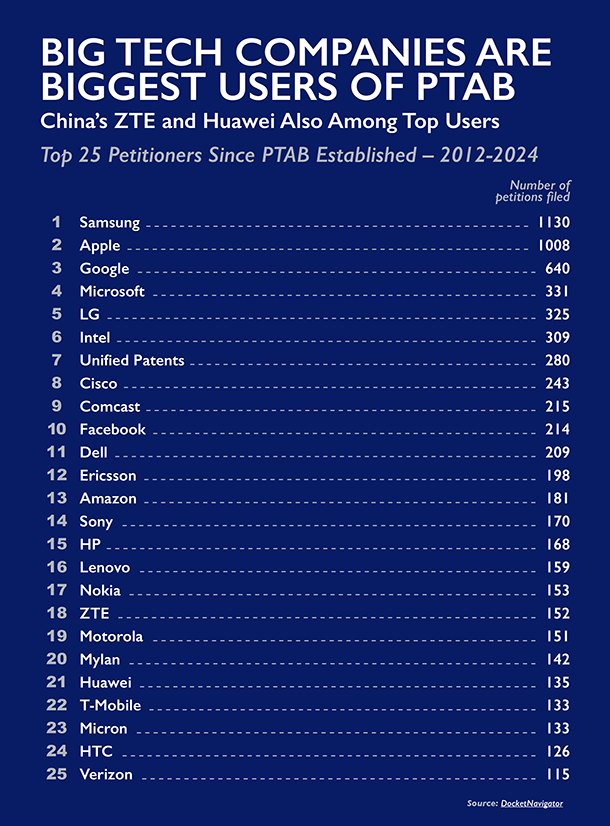Get The Facts
Patent Infringement in the United States
To Big Tech and many other large corporations, predatory patent infringement is good for business. They find it cheaper and simpler to steal a patent owner’s idea than to license and pay to use the invention. They know how to take advantage of their greater financial and legal resources and weakened patent laws to drag out legal proceedings until small inventors give up or go under.
To undermine patent rights, Big Tech companies have promoted a story about so-called “Patent Trolls” that has obfuscated the real issues plaguing the patent system. They have perpetuated the notion that patent litigation is out of control and the patent system is being over-run by bad actors who are maliciously suing innocent users of technology for patent infringement. In fact, the patent litigation rate has slightly decreased in recent years. The Patent Troll story is false, but it has big money behind it. By spreading this false narrative, they have found support in the courts and in Congress for changes and rulings that have weakened patent rights – and inventors’ ability to protect their patented inventions.
Why has Big Tech been funding this campaign to make patent holders out to be the bad guys under the false narrative of Patent Trolls?
- To kill competition – A patent owner with a disruptive idea represents a competitive threat. By stealing the idea and driving the patent owner out of business, Big Tech can secure its market dominant position.
- To cut costs – Instead of investing the time and resources to conduct R&D and innovate on their own, the corporation can take the inventor’s idea and jump right to manufacturing and selling. Big Tech companies think, “Why pay to license someone’s invention when you can just steal it?” Stealing IP allows these companies to reduce their input costs and increase their profit margins.
Restoring Injunctive Relief
A patent grants its owner the right to prevent others from making, selling, using, or importing their invention without permission. For more than two centuries, a patent owner whose rights had been infringed could obtain a permanent injunction to enforce that right and stop theft of their intellectual property.
In 2006, the Supreme Court undermined this right in eBay v. MercExchange by altering the legal test for obtaining an injunction and holding that money damages for past infringement should be sufficient. If courts won’t enforce a patent by preventing others from using an invention, that calls into question what rights the patent bestows and seriously undermines the value of the patent.
The rapid decline in injunctive relief since the eBay decision has allowed Big Tech and other large companies to steal the inventions of smaller competitors with impunity. Without injunctions as a remedy, it is cheaper for megacorporations to steal patented technologies and risk the possibility of paying a court-ordered royalty after months or years of expensive litigation than it is to follow the law and pay for a license up front.
When inventors cannot enforce their patent rights, investors are reluctant to fund the risky and long-term R&D needed for continued U.S. technological leadership.
The Problem with the PTAB
The USPTO’s Patent Trial and Appeal Board (PTAB), created in 2011, was intended to provide a cost-effective alternative to district court litigation for resolving patent disputes. Instead, the PTAB process is being abused by Big Tech and other large companies who use the administrative body to attack the patents of smaller innovators, so they can use their inventions without paying licensing fees.
The PTAB has invalidated 84% of the patents it has reviewed – far higher than the invalidation rate in district court – which led a former Federal Circuit Court Chief Judge to describe the PTAB as a “death squad” for killing property rights.
It’s not just Big Tech that’s using the PTAB to attack the patents of smaller innovators. In addition to the U.S. tech giants, the top 25 PTAB users includes China-based ZTE and Huawei, who have filed hundreds of petitions before the PTAB attempting to invalidate the patents on technology they are using in their products.

Why is Protecting Intellectual Property and Patent Rights so Important to U.S. Economic Strength?
- IP-intensive industries account for $7.8 trillion in economic activity annually – more than one 40% of economic output
- These industries support 63 million jobs – approximately 44% of all jobs in the United States
- Workers in these industries earn significantly more than workers in non-IP-intensive industries
For more facts about patents, head over to the Innovation Alliance website to read Patents: Myths vs. Facts.
The Threat from China
The weakening of the U.S. patent system, which has been instrumental to our country’s growth and economic strength, has given an opening to our biggest economic competitor, China. The United States has fallen in key rankings of global innovation – falling out of the top ten in Bloomberg’s Innovation Index and in key indicators of innovation tracked by the Information Technology & Innovation Foundation (ITIF). And a leading security think tank recently reported that China is now leading the U.S. in the development of 37 of 44 critical emerging technologies.
Meanwhile, China has moved in the opposite direction on patents, modifying its system to complement government-funded efforts and incentivize its own innovators in its quest to overtake the United States as the world’s leading technological innovator. As a national commission wrote in a recent report: “China is poised to ‘fill the void’ left by weakened U.S. IP protections, particularly for patents, as the U.S. has lost its comparative advantage in securing stable and effective property rights in new technological innovation.”
